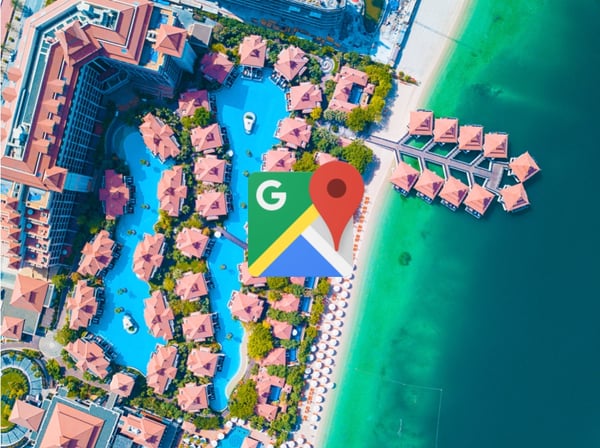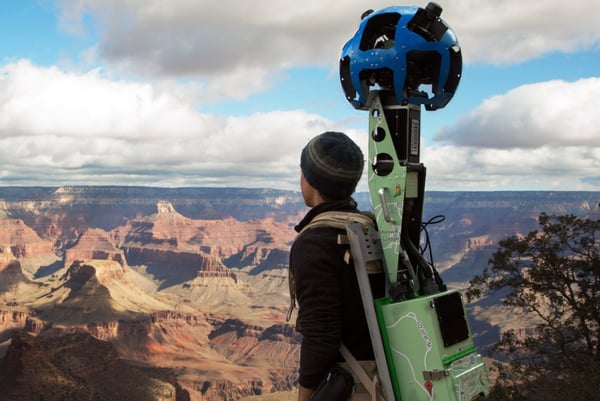Today's Google Maps: What Travel Brands Need To Know
April 30, 2019

Directions were only the beginning.
It has over 1 billion active monthly users. Over 650 million miles are driven using it every single day. And each day, people add more than 20 million reviews and ratings to it.
We could only be talking about one thing: Google Maps, easily one of the most ubiquitous mobile apps in use today. While it wasn’t the first mapping app to hit the market—it got beat by both Yahoo! Maps and MapQuest in that regard—it certainly had the greatest long-term vision behind it. Today, it’s often referred to as a “Super App,” used as the starting point for a wide range of searches and services.
How advanced has Google Maps become? Consider this: with its latest update, you can now use Google Maps to locate available EV charging stations in real time. This ain’t just about getting directions to grandma’s house anymore.
Googles Maps' status as a “Super App” has profound implications for travel brands as well. Indeed, Google Maps is now firmly established in the travel planning business, relevant to travelers through every phase of the trip planning and vacation journey. In other words, just making sure your property can be found on Google Maps isn’t enough.
So what can you do to make sure your destination or property is Google Maps friendly? Here are five things to consider:
1. Know how people use it now
We can no longer think of Google Maps as simply a tool for getting directions to a place we’ve chosen to go. Today, it has morphed into the way people actually make those choices.
Take resorts. With a simple, initial search of resorts in any given location, the user can get an overlay of all the properties that meet their criteria, and are one click away from customer reviews, photos of the property, and a list of nightly room rates. Also displayed is the location and proximity to top nearby tourist draws, restaurants, and more.
In short, what once could be accomplished only by exploring several distinct travel sites can all be done right from Maps.
2. Think beyond the street
Street View was another game changer for Google. By now we’ve all seen those ubiquitous Google camera cars out on the road, but it isn’t just streets people are viewing today. Way back in 2013, Google began adding ski runs for any resort with over three lifts. Then they took it further, and today, you can explore the slopes at hundreds of resorts right from the map app using Street View. More and more skiers now use it as a mobile trail guide in replace of traditional printed maps. User expectations also include the ability to search on-mountain facilities like restaurants and restrooms. Optimizing any resort's location for Maps will help create a more seamless visitor experience.
3. Take it inside
For museums, theme parks, resorts, parks, or stadiums, Google has made it easier than ever to create maps that help visitors move around both indoors and outdoors with ease. And just like on the mountain, Google Street View is going further than ever as well, giving these destinations the ability to create stunning tours of their locations right on the map app. Google proudly claims that no venue is too small, and has licensed its 360-degree tour technology to small businesses all over the country who specialize in capturing these tours for local businesses.
 Google has licensed its 360 technology to creators across the country, letting destinations create tours of just about anything.
Google has licensed its 360 technology to creators across the country, letting destinations create tours of just about anything.4. Let them book
So they may want to plan their trip via Maps, but surely they'll want to leave the site to book it, right? Wrong. The more a user can accomplish from right where they are, the more likely they are to do it.
This is user behavior that we know firsthand. Years ago at Slingshot, we developed the first HTML banner ever to run on the Internet, and we did it for a travel brand. The whole idea was to allow a user to initiate a hotel search directly from a banner, without leaving the page they were on. Common stuff today, but hey, this was 1995 we’re talking about. (You can learn more about it here).
Google is using this same principle today with Maps, taking users through much of the booking process without moving them to a new site. Users appreciate this, so it’s only in the brand’s interest to ensure they have this option.
What's more, with people now using Google Maps to make restaurant reservations, book flights, hail an Uber, or order food for delivery, the expectation that one can book right from the app will only grow stronger. Any brand not optimized for in-app booking stands to miss out on serious revenue.
5. Directions still come first
Despite everything above, Google knows that the key to success with Maps lies in the core utility, and as Skift has reported, they’re determined to keep making directions easier to get and more accurate to use.
The role Google Maps plays in how people search for, plan, and book travel is growing by the minute. Google’s parent company sees Maps as the next great frontier in driving future profits, so you can expect Google to continue making Maps more attractive to both travelers and travel brands. Make sure you take full advantage of all the tools and resources Google offers travel brands in the fascinating, evolving world of map-based search.



